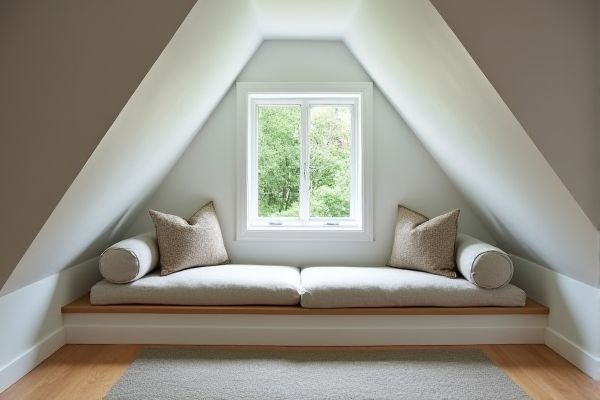
An attic recessed window seat maximizes space by fitting seamlessly into your attic's unique angles, offering built-in storage and a cozy nook that blends with your architecture. To discover which option best complements your space and style, read on to explore the benefits of each choice.
Table of Comparison
| Feature | Attic Recessed Window Seat | Freestanding Bench |
|---|---|---|
| Installation | Built-in, fixed in place | Portable, no installation required |
| Space Efficiency | Maximizes attic window area | Consumes additional floor space |
| Customization | Custom-sized to fit window space | Available in various sizes and styles |
| Storage Options | Often includes integrated storage drawers or cabinets | Optional under-seat storage |
| Mobility | Fixed, not movable | Easily relocated |
| Cost | Higher due to custom build and installation | Generally lower, budget-friendly options available |
| Aesthetic Appeal | Seamless integration with attic design | Varied styles can complement different decor |
| Comfort | Tailored cushions and ergonomic design possible | Standard cushions, may lack customization |
Understanding Attic Recessed Window Seats
Attic recessed window seats maximize space by fitting directly into window alcoves, offering built-in storage options and a cozy nook without occupying additional floor area. Unlike freestanding benches, these seats enhance natural light exposure and maintain seamless room flow, essential in compact attic environments. Installing a recessed seat can increase both functionality and aesthetic appeal while preserving attic headroom and maximizing usable space.
What Is a Freestanding Bench?
A freestanding bench is a movable seating option that can be placed anywhere in your attic space, offering flexibility in design and functionality. Unlike an attic recessed window seat, which is built into the wall or window alcove, a freestanding bench does not require permanent installation and can be easily repositioned or replaced. This makes freestanding benches ideal for renters or those who want to frequently change their attic layout without structural modifications.
Space Optimization: Recessed vs Freestanding
Attic recessed window seats maximize space by integrating seamlessly into wall cavities, eliminating the need for extra floor area and creating a streamlined, cozy nook. Freestanding benches, while versatile and movable, occupy valuable floor space that may limit room functionality in smaller attic areas. You can optimize your attic's spatial efficiency by choosing recessed seats for built-in storage and a clutter-free environment.
Installation and Construction Differences
An attic recessed window seat requires precise framing and insulation integration during installation to fit seamlessly within the wall cavity, ensuring optimal space utilization and energy efficiency. In contrast, a freestanding bench offers simpler construction with no need for wall modifications, allowing for easy placement and relocation. Your choice depends on whether permanent built-in aesthetics or flexible furnishing is a priority.
Comfort and Customization Options
An attic recessed window seat offers superior comfort by integrating cushioned seating tailored to the space's unique dimensions, maximizing both coziness and functionality. Customization options include built-in storage, upholstery fabric choices, and fitted cushions designed to complement the attic's architectural style. In contrast, a freestanding bench provides portability and flexibility but often lacks the tailored fit and built-in features that enhance comfort and personalized design in attic areas.
Storage Solutions and Functionality
An attic recessed window seat maximizes storage by utilizing built-in compartments beneath the seating area, offering a seamless and space-saving solution ideal for smaller attics. In contrast, a freestanding bench provides flexible placement options and can offer storage through drawers or lift-up seats but may occupy more floor space. Your choice depends on whether you prioritize integrated storage efficiency or movable functionality for varied attic layouts.
Aesthetic Appeal and Design Flexibility
An attic recessed window seat offers a seamless, built-in aesthetic that maximizes space and creates a cozy, integrated nook with custom cushions and storage options tailored to your attic's unique dimensions. In contrast, a freestanding bench provides greater design flexibility, allowing you to change styles, colors, and placements easily while adding a traditional or contemporary touch depending on your decor preferences. Your choice between the two depends on whether you prioritize a permanent, space-saving installation or adaptable furniture that can evolve with your interior design needs.
Cost Comparison: Which Is More Affordable?
An attic recessed window seat typically costs more due to custom construction, insulation, and built-in cabinetry, while a freestanding bench offers a more budget-friendly and flexible option. Custom recessed seats require professional installation and may involve structural modifications, increasing overall expenses. Your choice depends on whether you prioritize a seamless, space-saving design or a cost-effective piece that can be easily moved.
Maintenance and Durability Considerations
Attic recessed window seats typically require less maintenance due to their built-in design, which minimizes exposure to dust and physical damage. Freestanding benches, while easier to move and replace, often need more frequent cleaning and inspection for wear, especially if made from delicate materials. Durable materials such as hardwood or metal frame enhance longevity for both options, but recessed seats benefit from structural stability integrated into the attic framework.
Choosing the Best Option for Your Attic Space
An attic recessed window seat maximizes space by integrating seamlessly into your existing architecture, offering built-in storage and a cozy nook that blends with your attic's layout. A freestanding bench provides flexibility, allowing you to move or replace it easily while adding a decorative element that suits evolving styles or needs. Consider your attic's dimensions, storage requirements, and how much you want the seating to integrate with your space when choosing between these two options for the best fit.
 homyna.com
homyna.com